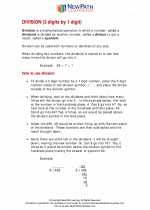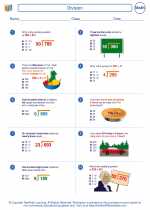Counting by Multiplication
Counting by multiplication is a method of counting where you add the same number repeatedly to find the total. This method is more efficient than counting by addition, especially when dealing with larger numbers.
Example:
If you want to count by 3s up to 30, you would start with 3 and then add 3 to get the next number, and so on: 3, 6, 9, 12, 15, 18, 21, 24, 27, 30.
Study Guide:
- Understand Multiplication: Before counting by multiplication, it's important to have a good understanding of multiplication. Make sure you are comfortable with the concept of multiplying a number by another number.
- Identify the Counting Interval: Determine the number you want to count by. This will be the interval at which you add the number to get the next count.
- Start Counting: Begin with the first multiple of the counting interval and continue adding the interval to find the next counts.
- Write Down the Counts: As you find each count, write it down to keep track of the sequence of numbers.
- Check Your Work: Once you have reached the desired total, double-check your work to ensure that you haven't missed any counts.
Practice Problems:
1. Count by 5s up to 50.
2. Count by 4s up to 40.
3. Count by 7s up to 70.
Now you can start practicing counting by multiplication and become more comfortable with this method of counting!
.◂Math Worksheets and Study Guides Sixth Grade. Division
Study Guide Division
Division  Worksheet/Answer key
Worksheet/Answer key Division
Division  Worksheet/Answer key
Worksheet/Answer key Division
Division  Worksheet/Answer key
Worksheet/Answer key Division
Division 

 Worksheet/Answer key
Worksheet/Answer key
 Worksheet/Answer key
Worksheet/Answer key
 Worksheet/Answer key
Worksheet/Answer key

The resources above cover the following skills:
Connections to the Grade 6 Focal Points (NCTM)
Number and Operations: Students' work in dividing fractions shows them that they can express the result of dividing two whole numbers as a fraction (viewed as parts of a whole). Students then extend their work in grade 5 with division of whole numbers to give mixed number and decimal solutions to division problems with whole numbers. They recognize that ratio tables not only derive from rows in the multiplication table but also connect with equivalent fractions. Students distinguish multiplicative comparisons from additive comparisons.